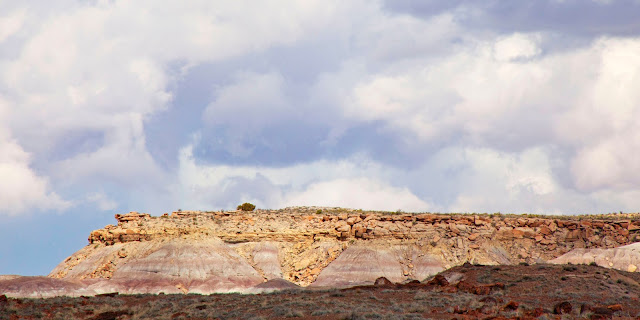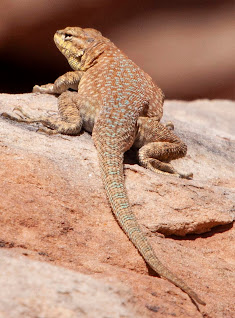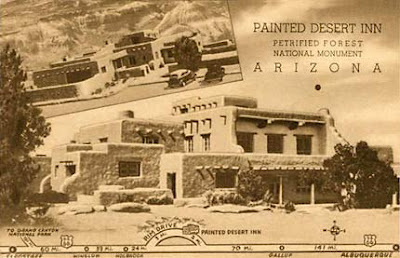Our next destination was Petrified Forest National Park,
which I blogged about in March 2018 and March 2015.
I guess I like to go in March!!!
 |
| Painted Desert |
Just a little background on Petrified Forest:
 |
| Close-up of quartz incursion |
Named for its large deposits of petrified wood, Petrified Forest National Park covers about 230 square miles of semi-desert, badlands and the Painted Desert. It is a vast and amazing display of a huge deposit of fossils of trees that lived in the Late Triassic Period, about 225 million years ago.
As I mentioned, the Park is remote; the closest town is
Holbrook, 25 miles away. The Navajo Nation borders the Park on the north and
northeast. State-owned land, federal land controlled by the Bureau of Land
Management and private cattle ranches adjoin the other borders.
The Park's
elevation varies from 5,340 feet along the Puerco River to 6,230 feet at Pilot
Rock; the average elevation is roughly a mile high.
The terrain varies from eroded
badlands in the north ...
 |
| Painted Desert |
... to hills and petrified wood deposits in the south ...
 |
| Log balanced on top of a butte |
Geology
Why are there giant fossilized logs lying willy-nilly across
this landscape?
Well, as we all know, over the millennia, the continents have migrated, shifting across the Earth’s surface, smashing together and pulling apart. Plus, climates have changed.
 |
| Huge petrified wood deposits |
The land that is now the National Park was once near the equator on
the southwestern edge of the supercontinent Pangaea. Then, it was a low-lying sub-tropical
plain flanked by mountains to the south and southeast and an ocean to the west.
Streams flowing across the plain from the mountains deposited inorganic
sediment and organic matter, including trees, plants and animals that had
fallen into the water.
Then, there were a series of volcanic eruptions that
quickly buried the deposited organic material, sealing it off and preventing it from being eaten or
decaying.
Groundwater dissolved silica (silicon dioxide) from the volcanic
ash and carried it into the porous fallen trees, forming quartz crystals that over
thousands of years replaced the organic matter. In other words, the trees
turned to stone. There are two types of petrified wood – some that still
contains wood embedded in stone and some that is pure quartz.
 |
| This one has the roots preserved |
Traces of iron oxide and other substances combined with the
silica to create the many bright colors in the petrified wood. Oh, and the
colors are gorgeous!
 |
| Colors of petrified wood |
At least nine species of extinct fossilized trees are found
in and around the park.
 |
| Petrified log |
Petrified wood is interesting. It simultaneously looks like
wood and like rock. Some of the logs and trees even look as if they were sawed into
pieces, but actually cracked neatly (quartz has a crystal structure) as they
settled.
The Park is part of the Painted Desert, which is a beautiful
and entirely accurate name.
It is part of the Chinle Formation, an
up-to-800-foot-thick layer of soft fine-grained stone, harder sandstone and
conglomerate and limestone. Beginning about 60 million years ago, tectonic
forces pushed up the Colorado Plateau, exposing it to increased erosion.
The
Chinle layer contains bentonite clay, which swells when wet and shrinks while
drying, causing surface movement and cracking. Bentonite also accounts for an
incredible blue color in some of the rock.
 |
| The layers are striking |
 |
| Park butte |
All of the Park's rock layers above the Chinle have been
removed by wind and water. In addition to petrified logs, fossils found in the
park include Late Triassic ferns, cycads, ginkgoes and other plants as well
giant reptiles called phytosaurs, large amphibians and early dinosaurs.
 |
| Petrified Forest's Chindesaurus Bryansmalli, one of the oldest dinosaurs ever found |
History
The park's earliest human inhabitants arrived at least 8,000
years ago. By about 2,000 years ago, they were growing corn in the area and
shortly thereafter building pit houses.
Later inhabitants built above-ground houses and storerooms
that may have been capable of storing food for more than a year. Between 900
and 1275, the area had more than 200 pueblos.
 |
| Agate House Pueblo; Photo: National Park Service |
The first were single-family homes but as soils became
exhausted, many were abandoned in favor of large multi-room pueblos close to dependable
sources of water. As the weather became dryer, the residents started leaving, abandoning
the area by 1380.
More than 600 archeological sites – most between 650 and
2,000 years old – have been discovered in the park.
This is "Newspaper Rock," which is neither a newspaper nor a single rock.
 |
| Newspaper Rock |
It features
more than 650 petroglyphs, which are images, symbols and designs scratched,
pecked, carved or incised on rock surfaces on a patina known as “desert
varnish.”
 |
| Mountain Lion petroglyph on display in the Painted Desert Inn |
The Newspaper Rock group of petroglyphs appears to have been added to by many
people over many years, which would not create a
linear story. This makes it impossible to "read" the rockface as a narrative. Native peoples' interpretations include family or clan symbols, spiritual
symbols, calendar events, territory boundaries and migratory routes.
 |
| White-Tailed Antelope Squirrel |
While photographing Newspaper Rock, I noticed a slight
movement and got a few shots of tiny White-Tailed
Antelope Squirrel using the rock for cover.
In the 16th century, Spanish explorers visited the area and,
by the mid-19th century, a U.S. team had surveyed an east-west route through
the area. Later, roads and a railway gave rise to tourism.
One wagon road,
built between 1857 and 1860, used camels for transport. In the late 19th
century, settlers and private stagecoach companies passed through the area. Homesteaders
developed cattle ranches on the grasslands; cattle grazed in the Petrified
Forest until the mid-20th century.
When tourists discovered the petrified logs in the late 19th
century, they thought nothing of
grabbing a few and taking them home. Commercial ventures sprang up and
tons of valuable historic remains were carted off. To protect these national
treasures, the area was declared a National Monument in 1906 and a National
Park in 1962. Now, of course, it is illegal to move, deface or remove any
materials. Still, theft is a problem, with an estimated 12 short tons of fossil
wood taken every year.
 |
| Closed gate |
And, it’s this that leads to the ridiculous hours for the
park. It opens at 8:00 a.m. and closes at 5:00 p.m., with longer hours in the summer.
And this isn’t a “you can’t enter after 5:00 p.m.” rule, it’s a “you have to be
OUT by 5:00 p.m.” rule. Rangers sweep the park from the middle starting at 5:00
p.m.
One reason this is a problem is that the most beautiful
colors are at sunrise and sunset – something that is shown in a great deal of
detail in the Park’s brand-new overview film shown at the Visitor Center.
Oh,
and it’s a dark sky destination as well, something else the film touts. Unless you get a backcountry pass, you can’t
enjoy either of these Park features.
 |
| Photo: EcologyWay.com |
We got there too late to go in. Well, the gates were closed,
but we MIGHT have been able to go to a close-by overlook for a few minutes. Still,
they would have kicked us out by sunset.
Very frustrating.
So, we got up early and entered the Park in the morning,
driving the 20+ miles from the Painted Desert in the north to the Rainbow
Forest in the south and then back again.
 |
| Trees and desert |
Flora and Fauna
Primarily a semi-desert shrub steppe, the Park is home to
447 species of flora, of which 57 species are invasive. The dominant plants
include more than 100 grass species, many native to the region, making the Park
some of the best grassland in northeastern Arizona. Willows, Cottonwoods,
rushes and sedges grow near the rivers.
 |
| Pronghorn at the Park, 2014 |
What did we see? One squirrel!
 |
| Common Raven, Grand Canyon |
A survey conducted in 2006 identified 216 species of birds
known to have occurred in Petrified Forest National Park since the park became
a protected area in 1906. Of those, 33-39 species breed within the park and 18
species live in the park year-round. Thirty-five species live in the park only
during the summer and 11 species only during the winter. The greatest diversity
of birds occurs during fall and winter migrations.
Birds commonly seen in the Park include the Common Raven, Western Meadowlark, Anna's Hummingbird and
Golden Eagle. We saw Common Ravens and
Horned Larks plus some brown birds too fast to photograph or ID.
 |
| Side-Blotched Lizard |
Among the reptiles are Collared Lizards, Plateau Striped Whiptails (a species consisting entirely of females), Side-Blotched Lizards, Gopher Snakes, Bull Snakes and Western Rattlesnakes. Amphibians, which drink no water but absorb it through their permeable skins, include Tiger Salamanders (the only salamander species known in Arizona), Woodhouse's Toads, Red-Spotted Toads, Great Plains Toads, New Mexico Spadefoot Toads, Plains Spadefoot Toads and Couch's Spadefoot Toads. What did we see? Nada! The photo at left was taken in Nevada.
Painted Desert Inn
 |
| Photo: National Park Service |
One place we stopped that I had not visited before was the Painted
Desert Inn, which I thought was still a working lodge but is actually a museum.
The original building from the early 1920s was made of petrified wood and today's
adobe facade dates to a 1930s renovation.
 |
| Snack bar stool |
Displays inside the museum highlight the building's history,
especially its role as a Route 66 inn and snack bar. The restored kitchen and lunch
counter are very cool to see and very southwestern in character.
From the early 20s to the early 30s, the original "Stone
Tree House" was a tourist attraction, with a lunchroom, shop, taproom and
motor car tours. Six tiny rooms were available for $2.00-$4.00 per night.
Unfortunately, the inn was built on a seam of bentonite clay
and the swelling and shrinking caused foundation damage.
In the early 1930s, Petrified Forest National Monument
purchased the inn and four square-miles of land for $59,400.
Due to the structural problems, the inn needed to be renovated. With the emerging popularity of
Pueblo Revival Style featuring stuccoed masonry, thick walls, earth tones, flat
roofs and projecting roof beams called vigas, the Painted Desert Inn was redesigned in the
1930s by National Park Service architect Lyle Bennett.
 |
| Painted Desert Inn menu |
Bennett started as a ranger in 1927, but moved on to use his
degree in fine art to become one of the best and most sought-after architects
in the National Park Service. More of his work can be seen at White Sands and
Bandelier National Monuments and Mesa Verde National Park. The Civilian
Conservation Corps (CCC) supplied to manpower for building and renovation.
In the 1930s, men were finding relief from the Depression
through the CCC. They built roads, buildings, trails and bridges in National Parks
and other federal and state areas, including Petrified Forest National
Monument.
 |
| Historic light fixture |
The CCC used ponderosa pine and aspen poles cut from nearby forests for roofing beams and smaller crossbeams (savinos).
Concrete floors were etched and painted with patterns based on Navajo blanket designs.
Light
fixtures were hand-made from punched tin, and wooden tables and chairs were
given American Indian designs.
 |
| Restaurant chair |
 |
| Skylight Panels |
The beautiful skylight panels were hand-painted by the CCC workers based on designs on prehistoric pottery. I have never seen anything like them before; they are quite pretty.
The Painted Desert Inn reopened in 1940, supplying Route 66
travelers with meals, souvenirs and lodging. It was popular with local
residents as a place for meetings and special events.
During World War II, the CCC was disbanded and travel was
curtailed by wartime rationing.
The inn closed in 1942, not reopening until
1947, this time under the management of the Fred Harvey Company.
The Harvey company had started as a partnership with the
Santa Fe Railroad in 1876 with a goal of bringing tourists west. It was well
known for comfort and quality.
In 1947, the company's architect and interior
designer, Mary Elizabeth Jane Colter, managed renovations and repair. She
created a new color scheme and placed windows in strategic walls of the Inn to
take advantage of the view. Colter also designed structures at the Grand
Canyon, including the Desert View Tower.
 |
| Mary Colter's Desert View Tower at the Grand Canyon |
Colter hired Fred Kabotie, a renowned Hopi artist, to paint
murals on the dining room and lunchroom walls. The scenes are glimpses into
Hopi culture: the Buffalo Dance, a trek to a sacred salt lake, planting time
and Tawa, the Hopi sun god (the sun face was also the logo of the Fred Harvey
Company). Kabotie had previously worked for the company at the Grand Canyon and
other locations.
 |
| Kabotie murals clockwise from left: planting, salt lake trip, sun logo, Buffalo Dance |
Colter was not the only woman to make history with the
Fred Harvey Company. Frustrated by rowdy male employees, the Fred Harvey
Company recruited women from towns and cities in the East and Midwest to serve
customers.
 |
| Photo: Katrina Parks |
These young ladies had to be of good moral character, have at least
an eighth-grade education, display good manners and be neat and articulate.
Their contract stipulated that they could not marry and must abide by all
company rules during the term of employment. If hired, the women were given a
rail pass to get to their place of employment, a uniform, good wages and room
and board. Since their beginning in the 1880s, the Harvey Girls have become
American legends.
 |
| Old postcard |
The Painted Desert Inn building is difficult to maintain as
the seam of bentonite clay beneath the foundation continues to cause cracks and
water damage. Structural damage forced the Harvey Company to move to a
new Visitor Center complex in 1963.
The Inn closed while they debated
demolition vs. preservation. The park set aside funds and scheduled demolition
of the building for 1975, but that was not to be.
After a public campaign to
save the Painted Desert Inn, the building was listed on the National Register
of Historic Places in 1976 and reopened on a limited basis as the Bicentennial
Travel Center. It became a National Historic Landmark in 1987.
 |
| Guests at Painted Desert Inn; Photo: National Park Service |
In 2004 and 2006, 13 "floating" roofs, joint-less
pipes in the walls and new flagstones were installed to help with drainage. The
inn is open year-round with shorter hours than the rest of the Park. During the
summer there is an ice cream parlor downstairs.
 |
| View from The Painted Desert Inn |


No comments:
Post a Comment